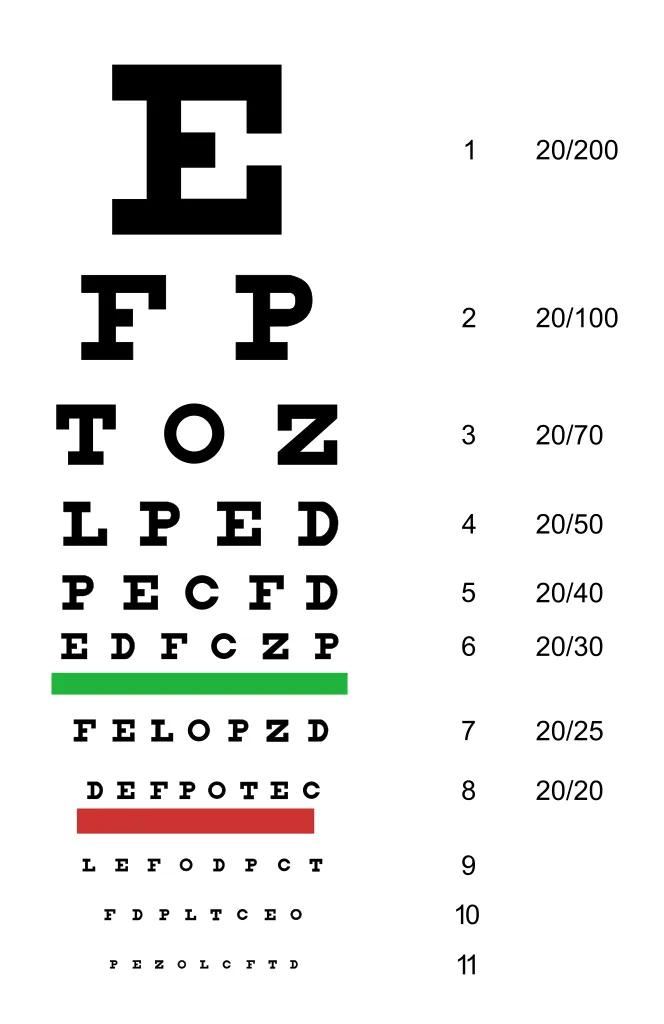Legal Blindness: What is it?
“Legal blindness” is a definition used by the United States government to determine eligibility for vocational training, rehabilitation, schooling, disability benefits, low vision devices, and tax exemption programs. It’s not a functional low-vision definition and doesn’t tell us much about what a person can and cannot see. Having low vision means that even with regular glasses, contact lenses, medication, or surgery, you may find it difficult to perform everyday tasks. Part 1 of the U.S. definition of legal blindness states this about visual acuity:

- Visual acuity of 20/200 or less in the better-seeing eye with the best conventional correction (meaning with regular glasses or contact lenses).
- This is a 20/200 visual acuity measurement, correlated with the Snellen Eye Chart (pictured at left):
- If you can only read line 1 (the big “E”) from 20 feet away while wearing your regular glasses or contact lenses, the doctor records your vision (or visual acuity) as 20/200 with the best correction.
- Update: In 2007, the Social Security Administration updated the criteria for measuring legal blindness using newer low-vision test charts with lines that can measure visual acuity between 20/100 and 20/200. Under the new criteria, if a person’s visual acuity is measured with one of the newer charts and cannot read any of the letters on the 20/100 line, they will qualify as legally blind, based on visual acuity of 20/200 or less.
Part 2 of the U.S. definition of legal blindness states this about visual field:
- OR a visual field (the total area an individual can see without moving the eyes from side to side) of 20 degrees or less (also called tunnel vision) in the better-seeing eye.
Using Low Vision Optical and Non-Optical Devices
Legal blindness does not mean total blindness. You or a loved one may have low vision. Low vision isn’t a legal term, it’s a functional description of how vision loss affects everyday life. It refers to a level of visual impairment that makes it difficult to perform daily tasks, even when using regular glasses, contact lenses, medication, or surgery. A person with low vision may find it challenging to read print, recognize faces, drive, or manage detailed work such as sewing or using tools.
This is where optical and non-optical devices come in. These tools—ranging from magnifiers and telescopic lenses to task lighting, contrast aids, and electronic video magnifiers—can make it possible to do the things you love, such as cooking, crafting, or managing finances independently. Low-vision optical, non-optical, and electronic magnifying devices can make it possible for you to do a variety of everyday tasks, including your favorite craft projects, preparing meals, and managing your finances.
To learn more about low vision, read What Is Low Vision? – ConnectCenter.
To learn more about the many different types of reading options available, see Reading and Writing Techniques – ConnectCenter.
Visual Impairment

Much like low vision, there are many different definitions of visual impairment. “Visual impairment” is a general term that describes a wide range of visual functions, from low vision to total blindness.
The World Health Organization uses the International Classification of Diseases (ICD 11) definition of visual impairment and blindness.
Understanding definitions of visual impairment and functional vision – PMC nih.gov
- Normal: 20/10-20/25
- Near normal visual impairment: 20/30-20/60
- Moderate visual impairment: 20/70-20/160
- Severe visual impairment: 20/200-20/400 or 11-20 degrees on visual field
- Profound visual impairment: 20/500-20/1000 visual acuity or 6- 10 degrees on visual field
- Near total visual impairment: Counting fingers, hand motion, light perception, or 5 degrees or less on visual field
- Total visual impairment: No light perception
Like the term “legal blindness,” “visual impairment” is not a functional definition that tells us much about what a person can and cannot see. It is a classification system rather than a definition.
Light Perception and Light Projection
These terms describe the ability to distinguish between light and dark or daylight and nighttime. A person can have severely reduced vision and still be able to determine the difference between light and dark or the general source and direction of light.
- The stereotypical assumption – that people who are blind or have low vision live in a type of “blackness” that sighted people see when they close their eyes – is generally inaccurate.
- Although every person sees differently, including persons with low vision, an individual with light perception/projection can perceive the presence or absence of light. Some people describe light perception as knowing when a room light is on or off or being able to walk toward a lighted lamp on a table in an otherwise darkened room.
Total Blindness
Total blindness is the complete lack of light perception and form perception and is recorded as “NLP,” an abbreviation for “no light perception.”
Few people today are totally without sight. 85% of all individuals with eye disorders have some remaining sight; approximately 15% are totally blind.
Next Steps: What Can I Still Do If I Am Legally Blind?
- You can still read.
- You can still cook.
- You can still work.
- In other words, you can still enjoy life!
If you or someone you know is new to vision loss, check out our step-by-step Roadmap to Living with Blindness or Low Vision.
For more information on the definitions of legal blindness, you can read Disability Evaluation Under Social Security, a publication from the Social Security Administration.